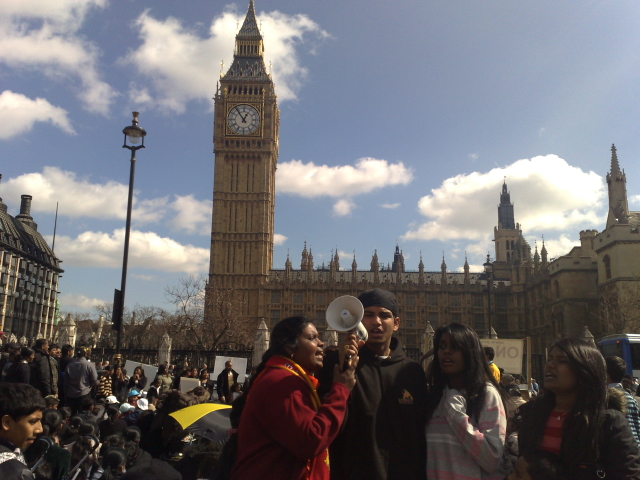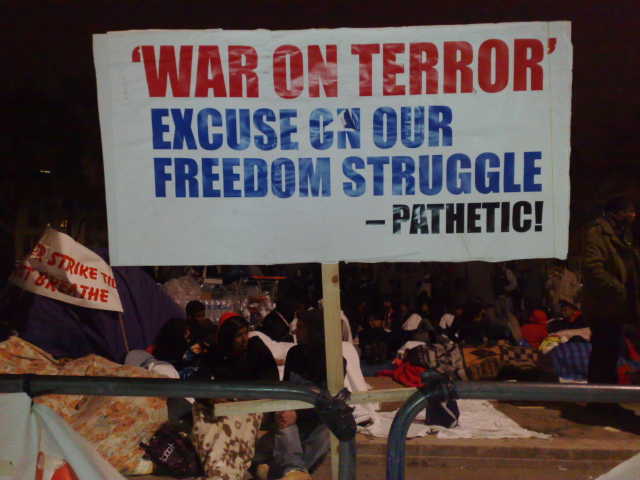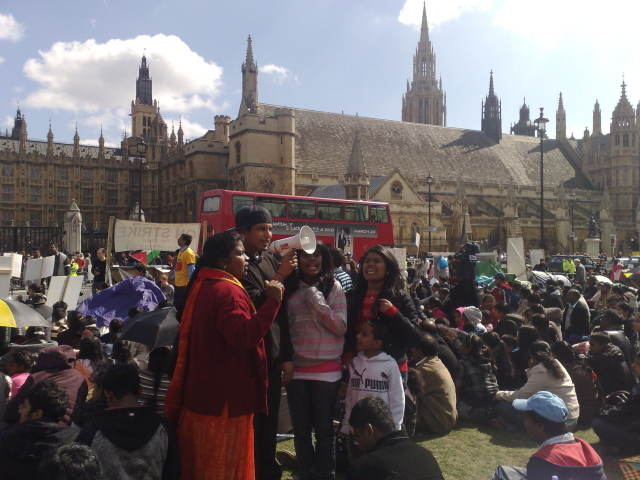There are two separate and mainly independent factors at work. One is the nature and evolution of the disease itself, which is not caused by human activity. Although social factors – for instance industrial pig farming – may conceivably have played a contributing role in the appearance of this particular disease, human beings didn’t invent viruses or human and animal vulnerability to them.
The other factor is just the opposite: What kind of society people live in, what drives the economic organisation of those societies and their social and political relations. In short, if the first factor concerns natural phenomena, itself, the second is the capitalist and imperialist world in which they occur.
Regarding the first factor, some crucial information is known: It is not unusual for farm people to catch flu from pigs, but what’s being called swine flu is something new and has never been detected in pigs before. Viruses mutate constantly, and different kinds are able to swap genetic material. The current swine flu has genetic elements that seem to have come from swine, birds and people. What makes it different than classical swine flu is that it can be readily transmitted between people. Its epicentre (where the original outbreak was centred) was not rural, but in Mexico City, a huge and dense concentration of people.
Other life-and-death biological issues remain unknown:
• How easily is the disease spread between human beings, how many of those exposed to the virus become ill, and what percentage of those who become ill die of it?
• Why have there been so many severe and mortal cases in Mexico while all the cases in other countries have been mild so far? Is this because of other factors in Mexico, such as the presence of other infections that work in tandem with swine flu? Is the virus undergoing a mutation that makes it less severe? Will there be further waves of this crisis?
• So far, most of those killed by the disease have been young adults, and none very old or very young. What does this say about how the disease affects the human body – does it force the body’s natural defences, the immune system, to act in such a way that instead of fighting off the disease it kills the patient? What does this mean for how it can be treated once people do get sick?
The following article is excerpted from part one of "Bird flu in an imperialist world", from AWTWNS 15 January 2007. The current swine flu epidemic and possible pandemic is not the same as the possible bird flu epidemic that article discussed. But insofar as this article focused on historical experience and general scientific knowledge about viral epidemics in humans, it remains relevant. The article puts emphasis on a worst-case scenario, not as a prediction but because the world’s authorities and the social system they represent can be judged by how seriously and effectively they work to prevent and prepare for such a catastrophe. The same standards apply today, no matter how this particular crisis unfolds
***
Flu viruses are now known to have caused many pandemics in the last few hundred years, including three globalized flu pandemics in the 20th century. The one in 1968-70, commonly called "Hong Kong" flu, was the mildest, killing about a million people worldwide. In 1957-58, the so-called "Asian flu" felled about twice that many. The deadliest, in 1918-20, labelled "Spanish flu" (although there is evidence that it first arose in the U.S.), killed between 20 and 100 million people – no one is sure. No other disease in history has cut down so many people so quickly.
A great many experts believe that such a mutation is bound to occur again sooner or later. David Nabarro, a senior World Health Organization (WHO) official and the UN’s coordinator for influenza, said, "I am certain that there will be another influenza pandemic sometime. In the natural history of these things, I am almost certain that there will be another pandemic soon."
Since by definition few people would be immune to a new strain of flu, the number of people who would get sick could be extremely high – in the hundreds of millions or even billions. How sick – how many people would die of it – is another factor that cannot be predicted. At one end of the scale of virulent infectious diseases, some are not dangerous on a world level because they are too lethal – people who get sick die too quickly to spread them effectively. An example of this is the Ebola virus. At the other end of the scale, ordinary seasonal varieties of flu affect millions and billions of people every year, but unless they are frail for other reasons, relatively few people die of them.
The 1918 flu circled the world in several waves. The first took nine months to infect almost every country. The flu virus was at its most lethal at the beginning. As it continued to mutate, it became weaker. So death tolls from place to place varied according to when the disease struck – and it struck many places two and three times. In Turkey and Iran, death tolls were very high. In parts of central India, where the death rate was the world’s highest, British colonial records indicate that almost eight percent of the population died, and the real numbers might have been higher. Japan was able to escape the worst by limiting travel, as were a few islands, but other islands and isolated populations were devastated. Europe and the US were hit hard. About 400,000 people died in France. Some American cities were all but spared. In others, like Philadelphia, nearly every family had someone sick. Horse-drawn carts were sent through every street as criers called "Bring out your dead! "; steam shovels were used to dig mass graves. The city's manufacturing and economic life ground almost to a halt. As described in The Great Influenza by John Barry, the city’s political and social structure had reached the edge of collapse when suddenly the disease ran its course.
Within two years, when nearly everyone in the world had been exposed to the disease, enough people had developed a resistance and it completely disappeared. A recent study involving the examination of tissue from a long-frozen corpse revealed that the 1918 flu originated in birds. Current prevalent scientific opinion is that all human influenza viruses probably originated in birds. [Pigs can serve as a way station in a chain of viral mutations.]
A study in the international medical journal The Lancet (21 December 2006) estimates the number of deaths a hypothetical new outbreak of a similar influenza would cause today, based on a statistical analysis of recorded deaths in 1918-20. The figure it came up with is 62 million dead. This, the study concluded, is probably the "upper limit" – the worst-case scenario.
But although this terrifying number is what made headlines, the study went much deeper. The scientists studied the relationship between those deaths and poverty. The relationship was not direct for many reasons, some of them chance and others non-class social factors (for instance, local population density – American troop ships headed for Europe became floating coffins). There was no cure or effective treatment for the "Spanish" flu then, when even the cause was a mystery, so medical care was not a factor. In fact, the study says that the reasons for the relationship between people’s income and why they died are still not thoroughly understood. The authors believe that the victims' general health, diet and other diseases ("co-infections") played a major role – although not the only one – in determining who survived and who did not.
Why is the experience of the 1918 flu relevant in looking at what might happen today? Hasn’t medical science taken enormous leaps since then?
First of all, it's not entirely clear how much medicine could do if a new lethal flu pandemic were to break out. The Lancet report says that even with advance preparation, six months could easily pass between the emergence of a disease and the development and manufacture of an effective vaccine. It is certainly true that contemporary medicine does have some potentially powerful tools, especially anti-viral drugs such as Tamiflu that cannot cure influenza but have proven effective in helping people sick with existing kinds of flu. There are also anti-bacterial drugs that could prevent or treat pneumonia in the wake of a viral infection, which may have been a major cause of death in 1918-20. Anti-inflammatory medications could also help prevent sick people from dying because their own immune systems overreact. But the WHO has warned that most of even the world's best medical systems might be overwhelmed and perhaps collapse.
Further, the study's grave concern is based on more social realities rather than the possible inadequacies of contemporary science in the face of such a challenge. Their statistical studies of deaths in 1918-20 lead them to conclude, "The burden of the next influenza pandemic will be overwhelmingly focused on the developing world." Some "96 percent of those deaths will be in the developing world, " they say.
The study’s comparison between 1918 and today is valid: "Health inequity [inequality] is scarcely less now than in 1918, and the medical advances of the last 96 years are unlikely to benefit much of the developing world in any future pandemic... Large stocks of antibiotics or anti-virals are unlikely to be available in most resource-poor countries during a pandemic. Therefore, perhaps the best estimate of mortality in a possible 2007 pandemic is that from 1918 – a rather damning indictment of global inequity in health care. "
In countries where other diseases are already widespread, the report's examination of the experience of the 1918 flu makes it horribly clear that many millions are at serious risk. It is known that malaria, for instance, left people especially vulnerable to dying of the flu. In today's world, as many as half a billion people have malaria. Another factor in our time is the unprecedented existence of up to 40 million people living with HIV/AIDS – and little or no immune system. These are the starting points for scenarios almost too grim to contemplate.
Malaria and AIDS are primarily (though far from exclusively, especially in the case of the latter) diseases of poor countries. This is one factor that led the study’s authors to conclude that Africa and Asia could be where the most deaths occur.
The decisive question, however, contrary to the study's terms, is not poverty but social system. The authors believe that differences in per capita (per person) income account for about half of the differences in death rates between different countries. Yet when China was still a socialist country, under the leadership of Mao, even though per capita income was less than today, the health situation of the people was far better than it is now. In a few decades of revolution, China wiped out many of the diseases that had preyed upon the people. When Chinese society was guided by the principal "Serve the people", the allocation of resources and the conscious participation and mobilization of the masses of people in many different ways more than doubled the average life expectancy. Since the restoration of capitalism (in fact, if not in words) when the right took power after Mao's death, the rural health care system has been largely dismantled, leaving two-thirds of the population – 800 million people – with little access to health care. Guided by the new principal "to get rich is glorious", when an epidemic of the SARS virus struck China’s countryside in 2003, instead of doing everything to stop it, the authorities covered it up so as to protect commerce and their own rule.
Also in regard to the question of social system, although the study rightly makes a crucial distinction between what it calls "developing" and "developed countries" and concludes that the peril is very different in these two cases, the difference between them is not just their degree of development. A major characteristic of the contemporary global economic, social and political system is the domination of most of the countries and peoples of the world by the monopoly capitalist rulers of a handful of imperialist countries. The crucial difference is not one of national incomes, but that in the dominated countries the economy – and ultimately almost everything else – responds to the needs of foreign finance capital.
It is inevitable that new and potentially dangerous diseases will arise under any social system, long into the future. The point is not that capitalism created this flu. But the way human beings are organized in today's imperialist world is an enormous obstacle to being able to deal with the problem.





















